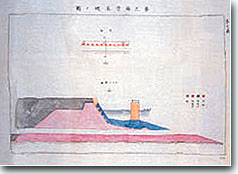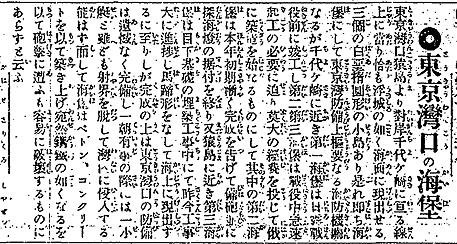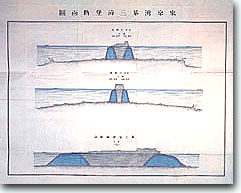Construction of the No.3 Sea Fort
The most difficult work was No.3 Sea Fort
No.3 Sea Fort is located 2,611m south of the No. 2 Sea Fort and 2,589m north of the Hashirimizu low battery, with a water depth of about 39m and strong tidal currents. This construction work became the most difficult military civil engineering work in the Meiji era.
(Incorporated Association) Japan Society of Civil Engineers: “Meiji Industrial History, Edition Civil Engineering edition” (1929.7.31) describes in detail the construction of No.3 Sea Fort, so let’s take a look at it.

“Tentative design of the upper part of the Base of No. 3 Sea Fort”
Meiji 43 Feb. (1910)
“Contemporary Japanese Military fortification History Part 2 Volume 1 Tokyo Bay Fortress Fortification History Appendix”
The National Diet Library

Hochi Shimbun(News Paper)
Meiji 40 Oct.28th (1907)
The National Diet Library
No.3 Sea Fort construction start (1892)
A pile of crushed stones were piled up on rubbles, and concrete was laid on for the higher part than the high tide to form an embankment.
The inside of the embankment was filled with sand.
In order to measure the holding capacity of the sand ground, a loading test was conducted, and the allowable ground holding capacity was set at 18 tons/m2.

“Tentative design of the upper part of the Base of No. 3 Sea Fort”
Meiji 43 Feb. (1910)
“Contemporary Japanese Military fortification History Part 2 Volume 1 Tokyo Bay Fortress Fortification History Appendix”
The National Diet Library

“No.3 Sea Fort cross-sectional view”
Meiji 39 (1906) (estimated)
National Institute for Defense Studies collection
The embankment repeatedly destroyed by high waves
However, the embankment constructed in such a hard work was suddenly destroyed by the high waves of Meiji32 Oct. (1899) and Meiji35 Sept. (1902). Finally, they installed 100 to 150 tons of concrete blocks against repeated damage due to high waves, but this was also destroyed by the high waves of Meiji 44 July (1911), leaving five people unidentified.
Therefore, we decided to install breakwater consisting of 13 concrete caisson boxes with a length of 14 m, a height of 7 m, an upper width of 4 m, a bottom width of 6 m, and a weight of 1,500 tons, outside of embankment.
However, due to the high waves in Taisho 6 Sept. (1917), six boxes of them moved, six boxes of them leaned, and only one remained in the original position.
In response, they cast 13 concrete blocks weighing 35 tons, and finally they could make it stable.
Construction costs were approx. 1.15 billion yen
No.3 Sea Fort was scheduled to be completed in Meiji 45 March (1912), but it was finally completed in Taisho 10 (1921).
By the time of Meiji 40 (1907), the construction costs alone were 2.49 million yen (present value of about 11.57 billion yen )
Armament of No.3 Sea Fort
The No.3 Sea Fort was equipped with four 15cm cannons and eight 10cm cannons and a search light.
Major Ronne’s view “The construction is the most reckless attempt in the world”
In Meiji 34 (1901), Lt. General Shinroku Ishimoto, who was the head of the fortification HQ, asked Maj. Renne of Germany who was an expert of fortification, to observe the No.3 sea fort under construction, and asked him comments on this project whether it would success.
“There is no example of construction in such a deep sea around the world. It is reckless to construct No.3 Sea Fort in the sea with a depth of 40 m or more, and directly facing the ocean with strong sea waves. Therefore it requires the utmost care and well preparation for its completion.
In order to reduce further subsidence, it is good to put sands on the foundation and apply pressure to press the sand layer “was his comments.
It turns out that it was a rare large scale construction work worldwide, at that time.

” Tide current direction Map of No. 3 Sea Fort”
Meiji 39 (1906) (estimated)
“Contemporary Japanese Military fortification History Part 2 Volume 1 Tokyo Bay Fortress Fortification History Appendix”
The National Diet Library
